
Germany will take on greater military leadership in global conflicts, requiring a sustained increase in defense spending and troop strength, according to plans for its first overhaul of security policy in a decade.
A “renaissance of classic power politics” is increasing “the risk of violent conflict between states, including in Europe and its neighborhood, as the example of Russia’s actions in Ukraine demonstrate,” according to a draft document by Chancellor Angela Merkel’s government obtained by Bloomberg. Merkel’s cabinet is expected to discuss the so-called white paper at its weekly meeting on Wednesday, just days after she and fellow NATO leaders including President Barack Obama met at the alliance’s summit in Poland.
Germany is ready to take on responsibilities and leadership, reflecting “our increased role in international security policy,” according to the document, which also backs further consolidation of Europe’s defense industry. Germany’s last white paper, adopted in 2006, describes the country only as a “reliable partner” in international military missions.
While containing caveats about self-imposed military restraint and acting in concert with Germany’s partners, the draft lays out a shifting view of outside challenges — from Russia to refugees — that’s already driving Merkel and her government toward a more assertive stance. That includes arming Kurdish fighters in Iraq, aiding U.S.-led airstrikes in Syria and leading a North Atlantic Treaty Organization battalion to be deployed in Lithuania as part of the alliance’s deterrence push against Vladimir Putin’s Russia.
With the U.K. poised to leave the European Union, Merkel also faces pressure to step up on other fronts: Italy’s banks may need aid to avoid another euro-area crisis, and Germany’s share of the EU economy will rise to a quarter from a fifth once Britain drops out.
Germany spends about 1.2 percent of gross domestic product on defense and Merkel said last week that “much remains to be done” to reach NATO’s goal of 2 percent. The U.S., which ensured Western Europe’s security for decades during the Cold War, spent an estimated 3.6 percent last year, according to NATO.
Germany’s armed forces face an unprecedented confluence and range of crises and conflicts, so defense spending and troop strength need to keep rising in the years ahead, according to the draft. That reflects the stance taken by Merkel and her defense minister, Ursula von der Leyen, who in May announced Germany’s first buildup of military personnel since the Cold War ended 25 years ago.
Set up after World War II as a bulwark against a Soviet-bloc invasion, Germany’s military has faced accelerating change under Merkel:
– Conscription was suspended in 2011 to speed the shift to a professional army
– Of Germany’s 177,000-strong armed forces, 3,300 troops are deployed on global missions from Afghanistan and the Horn of Africa to Mali and Turkish-Greek coastal waters
– Defense spending is set to rise almost 7 percent to 36.6 billion euros ($40 billion) in 2017, with further increases down the road
– All deployments still require parliamentary approval, seen as a post-Nazi safeguard against militarism
Signals that Germany is edging toward a more assertive stance have increased since German President Joachim Gauck, a former East German pastor, said in 2014 that the country needs to step out of history’s shadow and engage in international missions “earlier, more decisively and more substantially.”
In May, the Defense Ministry scrapped Germany’s post-Cold War upper limit of 185,000 military personnel, adding 14,400 soldiers as well as 4,400 civilian employees over the next seven years.
“Rarely has the German military faced higher demands than in the last few months,” von der Leyen said at the time.

